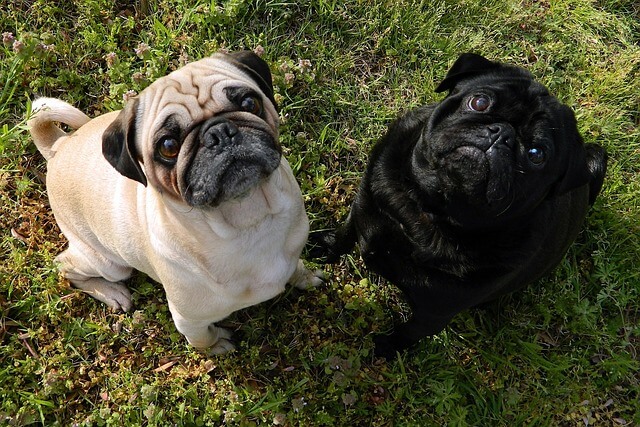Pug Dog: Care and Training
The Pug is often called a big dog in a small package (“multum in parvo,” “much in little”) and that describes these sturdy little dogs with their big personalities very well. The Pug is a very old breed, dating back to at least 400 BC in China. They have been the favorites of Chinese emperors and royals in Europe for centuries. Today they are popular companion dogs around the world.
History of the Pug
The Pug was probably closely related to the Pekingese at one time, and both breeds are very old. The Pug dates back to at least 400 BC in China and we know that the little dogs were kept in Tibet in Buddhist monasteries. Later Pugs were exported to Japan and, when explorers and traders from the West began visiting the Orient, the dogs were taken back to Europe as early as the 16th century. Early on, the Pug became associated with the House of Orange in the Netherlands when a Pug saved the life of William, Prince of Orange by warning him when he was about to be attacked in 1572. Later when William II landed in England his retinue included a number of Pugs. The breed became popular in England for years to come. Queen Victoria bred Pugs and helped establish the Kennel Club in Britain.
Pugs were also popular in France and the Empress Josephine used her Pug, named Fortune, to carry messages to her husband Napoleon when she was imprisoned.
More Pugs (and Pekingese) were brought back to England when British soldiers sacked the Chinese Imperial Palace in Peking in 1860. This was an immense benefit to the breed in Europe as it was the first time since the 16th century that any large number of Pugs had been taken out of China. The Pug was recognized by the American Kennel Club in 1885.
Health
Pugs usually live to be 12 to 15 years of age. However the Pug is prone to a number of health problems. They are a brachycephalic breed and, as such, they can easily become overheated when there are high temperatures or high humidity. They have somewhat protruding eyes and lack brow ridges which leaves their eyes susceptible to injuries such as scratched corneas and entropion.
Pugs can suffer from Pug Dog Encephalitis which is an inflammation of the brain. This condition also affects other small breeds. There is no cure for this disease. It can strike dogs between the ages of six months and seven years. There may be an hereditary component to PDE but that’s uncertain at this time.
Pugs are also predisposed to a condition called hemivertebrae because of their curled tail. When something goes wrong genetically and the screwtail affects another place on the spine, the result can be paralysis.
Pugs can also have problems because of the wrinkles on their face which leaves them prone to infections. If you have a Pug you will need to wipe your dog’s face frequently and clean it to keep bacteria from accumulating and infections from getting started. Pugs are also more prone to demodectic mange than most breeds.
Hip dysplasia is also a problem in the breed.
Pugs are also prone to becoming overweight and obese. They need regular exercise and you need to watch how much you feed your dog. Measure your dog’s food and don’t allow him to overeat. Watch the snacks, too.
Temperament and Training
Pugs make wonderful family dogs. They are very affectionate and they are devoted to their owners. They love children. They are also quite sturdy little dogs so they can withstand playing with small children. Pugs are usually very gentle dogs. They are quite clownish and they love to make people laugh. They are intelligent and very playful. They tend to make good watchdogs because they always notice what’s going on.
Pugs are very adaptable dogs, able to live in an apartment, a house, or enjoy a home with a larger yard. They do need to have some regular exercise but they are only moderately active dogs. They are most happy when they are with their people. It must be stressed again that they love their families. They are very outgoing, friendly dogs and they usually like everyone. They generally get along well with other dogs and pets.
Pugs are very intelligent and they are usually easy to train. However, they can get bored if you don’t find ways to make their training interesting. Fortunately, Pugs are usually food-motivated so they do well if you use treats and praise as a way to train them (positive reinforcement). Housetraining is not usually a problem.
Grooming
Pugs are usually easy to groom. They have a short, smooth coat which should be brushed regularly. However, these dogs do shed a lot according to all owners. They are particularly heavy shedders with the changing of the seasons, so be prepared to brush your Pug more during this time to keep hair from piling up in your home. Bathe your dog as needed.
Clean the wrinkles of your Pug’s face often to prevent any infections from getting started.
You should clean your dog’s ears weekly to prevent ear infections.
Trim your dog’s nails on a weekly basis to keep them short. If you trim them each week, removing just a small amount of nail, then you won’t cut the quicks or harm your dog.
Special Needs or Care
Remember that Pugs are a brachycephalic breed and they do not handle hot weather or humidity very well. Don’t take your Pug out in the heat or allow him to exercise when the weather is very hot.

